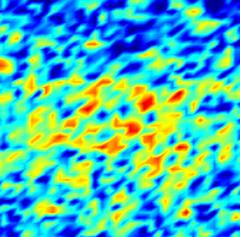URL: https://www.desy.de/news/news_search/index_eng.html
Breadcrumb Navigation
DESY News: Scientists observe “anti-freezing”
News
News from the DESY research centre
Scientists observe “anti-freezing”
An international team has observed an amazing phenomenon in a nickel oxide material during cooling: Instead of freezing, certain fluctuations actually increase as the temperature drops. Nickel oxide is a model system that is structurally similar to high-temperature superconductors. The experiment, published in the journal Physical Review Letters shows once again that the behaviour of this class of materials still holds surprises.

The scientists used the innovative technique of X-ray correlation spectroscopy at the Advanced Light Source ALS in California: This allowed them to track the order of elementary magnetic moments (spins) in space and time using coherent soft X-rays. These spins arrange themselves into a stripe-like pattern upon cooling. This ordering is not perfect at higher temperatures, but consists of a random arrangement of small locally ordered regions.
The researchers found this arrangement not to be static, but to fluctuate on time scales of a few minutes. As the cooling continues, these fluctuations initially become slower and slower and the individual ordered regions grow. So far, this behaviour corresponds to what many materials show: The less thermal energy is available, the more fluctuations freeze and order grows.
What is completely unusual and had never been observed in this way before was that as the material cooled down further, the fluctuations became faster again, while the ordered areas shrank. Stripe order thus decays at low temperatures both spatially and through increasingly faster fluctuations, showing a kind of anti-freezing.
This observation may help to better understand high-temperature superconductivity in copper oxides (cuprates). In cuprates, stripe order similar to that in nickelates is thought to compete with superconductivity. There, too, the stripe order decays at low temperatures, which has been explained as superconductivity, setting in at low temperatures, suppresses the stripe order. Since there is no superconductivity in nickelates, but the stripe order nevertheless decays at low temperatures, an important aspect seems to be missing from the present description of cuprate superconductivity. It is possible that the stripe order in cuprates is not simply suppressed, but also decays for intrinsic reasons, thus “clearing the field” for the emergence of superconductivity. A deeper understanding of this mechanism could help control superconductivity.
Reference:
Measurement of Spin Dynamics in a Layered Nickelate Using X-Ray Photon Correlation Spectroscopy: Evidence for Intrinsic Destabilization of Incommensurate Stripes at Low Temperatures; Alessandro Ricci, Nicola Poccia, Gaetano Campi, Shrawan Mishra, Leonard Müller, Boby Joseph, Bo Shi, Alexey Zozulya, Marcel Buchholz, Christoph Trabant, James C. T. Lee, Jens Viefhaus, Jeroen B. Goedkoop, Agustinus Agung Nugroho, Markus Braden, Sujoy Roy, Michael Sprung, and Christian Schüßler-Langeheine; „Physical Review Letters“, 2021; DOI: 10.1103/PhysRevLett.127.057001
Source: Release from Helmholtz-Zentrum Berlin



